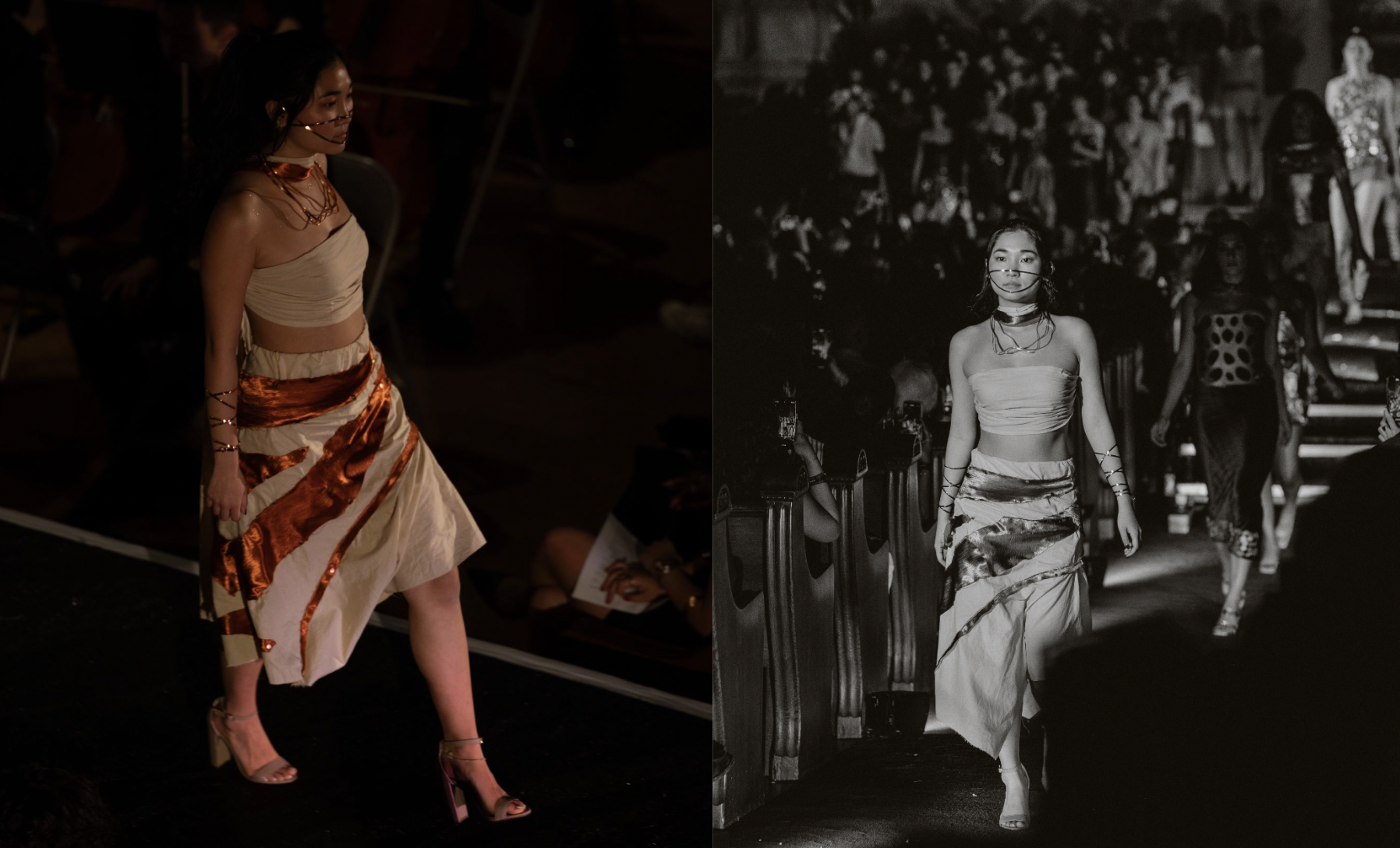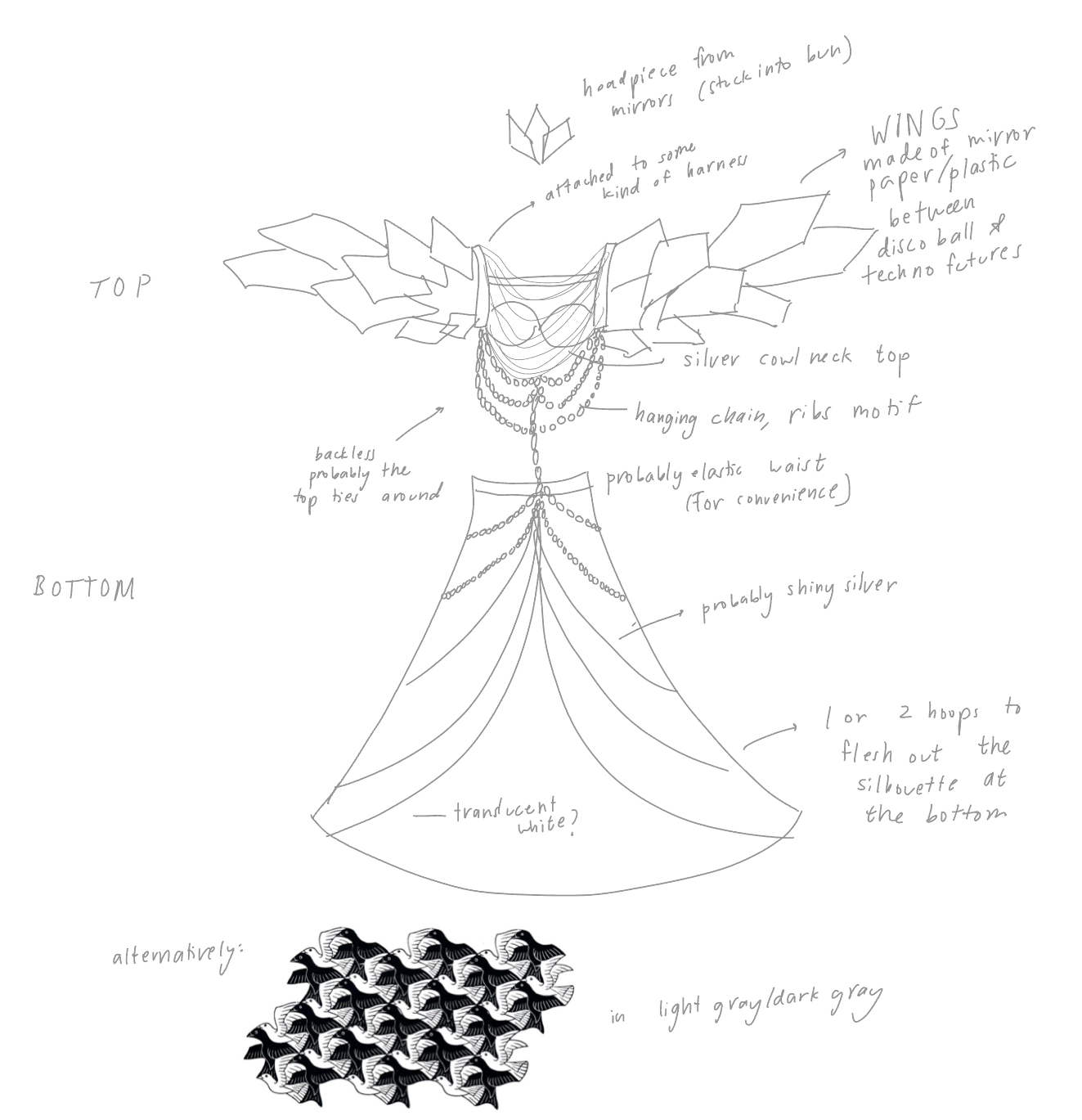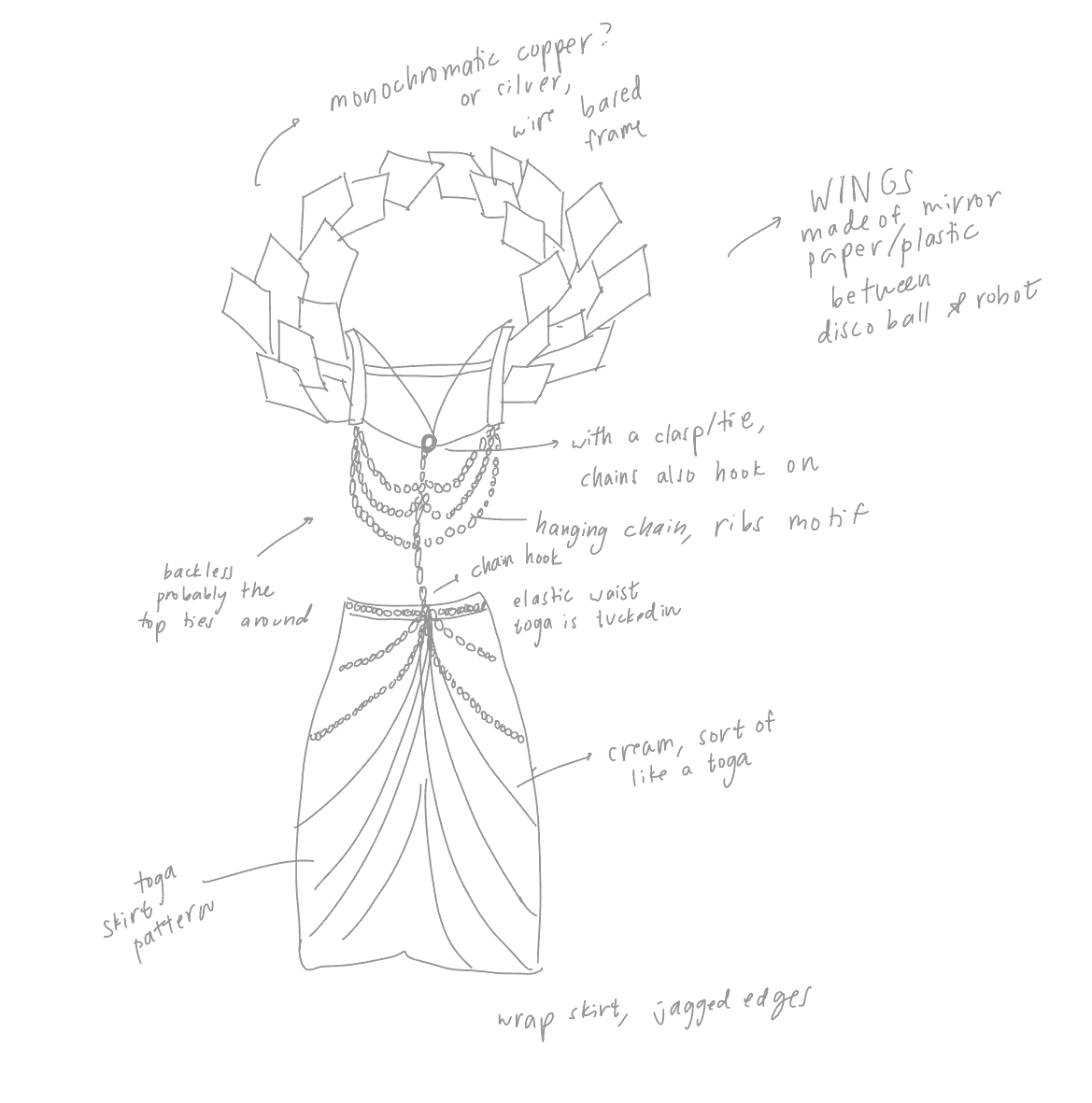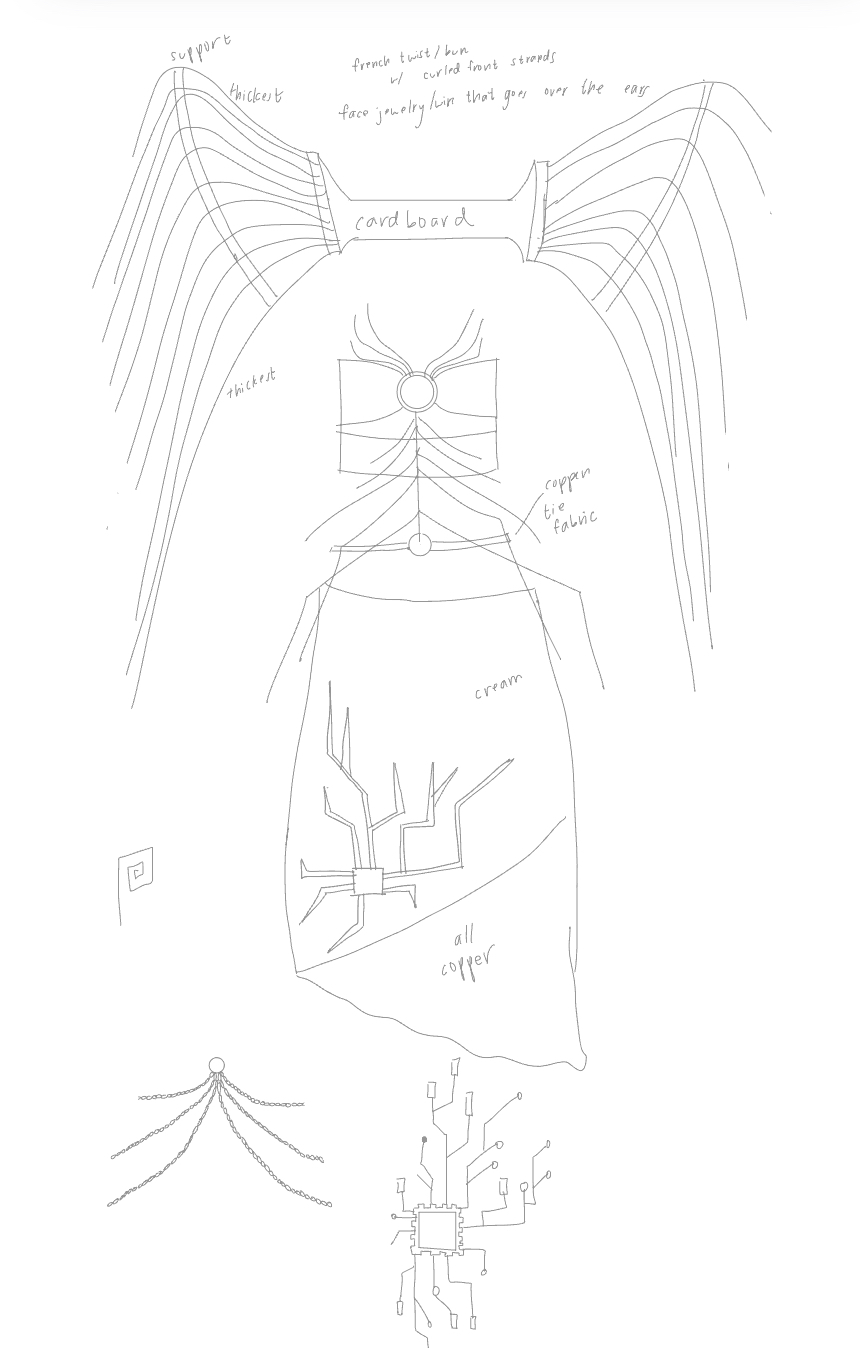making my first dress
February 17, 2025
So, I made a dress! My amazing model Catherine debuted it on the runway in Stanford’s Memorial Church last Saturday. This was my first time ever designing, and was one of 130 (!!) designs exhibited on FashionX’s Runway this year.

muslin two-piece with trailing sash, satin accent stripes, gold stud fastenings, wire face and body jewelry; show photos by Emily Gonzalez and Aaron Moses
process reflections
(1) Manual labor is really fun. Or at least, moonlighting as the kind of person who creates with their hands, in pursuit of some greater expression, is really fun. I’m very drawn to the idea of labors of love, of formidable efforts and craftsmanship driven purely by vision. Over the past year I’ve had this unshakable urge to do more crafts and make more art, to take Stanford’s design classes and become obsessed with Es Devlin’s prototypes, to break out of the routine of digital-only artifacts and offshore production chains and mass manufacturing. I went into this project not even knowing how to sew1, and it was marvelous to me that I could even make a line of machine-clean stitches, let alone to create something wearable and beautiful from rectangles of fabric. I plan to push myself to make more with my own hands, to physically materialize more ideas, to tighten the loop between imagination and corporeality.
(2) I anticipated the actual manufacturing learning curve to be steep, but somehow I didn’t anticipate that it would be so hard to execute on an actual vision. In general it seems like difficulty scales with level of specification: it’s easy to have some ambitious imagination, hard to turn that into a sketch, and harder still to turn that into a stitch-level plan. At points the manufacturing felt much more like engineering than art, and I was just as constrained by functionality/tractability as by creativity. I worked in a constant feedback loop of operationalizing a sketch with a minimal prototype, assessing whether the design would work (structural integrity was a big and unanticipated challenge here), trying it on in the mirror, breaking the stitches and restarting. Often I brought exciting but hazy imagination to an ugly reality; often the only “signal” I could muster was dislike2. But I enjoyed the real creative sparks – coming up with the ideas for the face jewelry and the hardware on the skirt – and also the iterative loop of assessing, adjusting, and ~immediately executing on my next idea. I realize that even the simplest article of clothing is an engineering feat, and that real haute couture is not just a creative expression but a true pinnacle of craftsmanship. It takes both technical effort and constant, recursive creative discernment to bring a vision to life.
(3) At times the process was emotionally difficult for me. On one hand I felt excited, even euphoric, as my vision was crystallizing; while I was forming a clear and ambitious roadmap I felt such thrill for the process. But I sometimes hit creative or technical walls, especially because I was working on a deadline and against my own high expectations, and then it was hard to avoid obsessive stress. I’m not quite a perfectionist, but I’m definitely an adversarial goalkeeper3. Candidly, even after finishing I found myself wishing I had pushed myself even more and created something grander. I wish I were better at anchoring myself to ambitious expectations while not hampering my creative expression or enjoyment of the final product. Still, I’m determined to design again next year, and to make independent creation a larger part of my life.
(4) Around the age of 9, I was obsessed with visual arts, and it was my dream to become a fashion designer; the corners and mantelplaces of my parents’ house are still littered with paintings I brought home and paper cutouts of dresses I designed. Obviously fashion school is not in the cards for me, but bringing a piece to life for the first time dredged up deep love and nostalgia for my childhood creativity. It’s one of the few times I’ve really felt I was revisiting something that my younger self dreamed of. For most of my teenage years my love of fashion design morphed into a general interest in clothing, scrolling Pinterest and dressing up for special occasions. It felt qualitatively different to return to the original childhood hobby. A quote I love and feel to be deeply correct: Parker Palmer4 writes that “our lives lay down clues to selfhood” and that our earliest years “need less deciphering to yield insight”. The desires exhibited by one’s younger, less-inhibited and less-influenced self often point to fundamental truths about one’s current self and inner life. Reflecting on those early memories I see tinges of the spontaneity, creative scrappiness, and occasional obsession that still shape me under the surface.
process gallery



The original design was primarily motivated by my interest in shapes and physical structure in garments (see the leftmost sketch). I was really interested in chains/jewelry (unsuprising, given that I’d just spent three months in Berlin), and “exoskeleton” garments with shapes and scales far removed from human form. The show’s theme was “Metamorphosis”, so I toyed a bit with Escher-inspired paintings, and also some lightly transhuman motifs (ribcages made of wire, silver wings made out of metal paper, a wormhole-ish inverse hoop skirt with questionable structural integrity). Also in my original Pinterest board: Winged Victory of Samothrace, the Kafka book, and some playful paper collages.
Anyways, I submitted that design in November for a FashionX internal deadline while I was still in Berlin, and didn’t really think about it until I was home after NeurIPS. Over winter break it hit me that I had absolutely zero sewing or construction experience. Thinking about my ability to actually execute on a design forced me to pare back some of the more extravagant structural elements, leaving me with the second iteration of sketch. At that point the human-transhuman, ancient-modern motif made its way into the design. This is when I got the idea to have a classic, maybe Greek-inspired silhouette for the actual dress, and mixed-metal wire, chain, and mirror accessories. I was broadly inspired by the “story” of progress, the notion of technology itself as our successor, and how the future forces us to revisit human fundamentals; I wanted a design that draped Hellenistic goddesses with modern circuitry.
I made the full chain ribcage, and bought everything to make the mirror-paper wings, but before I even finished the frame I convinced myself that geometric wings were just going to look aesthetically cheap5. This sent me back to the drawing board, where I decided that structures (wings, ribcage, headpiece) made of copper wire6 should be the main visual element, placed on top of a plain, toga-like dress. My final sketch liberally borrowed inspiration from Iris van Herpel’s half-alien, half-biological sculpture-dresses.
Clearly my actual dress retains none of the original sketch, and (generously) is only half faithful to my final sketch. It turns out dress silhouettes are quite hard to get right, so I ended up sewing the skirt off a pattern, since at this point I could barely use a sewing machine. At some point I ditched sketches entirely7, and worked exclusively with physical prototypes, cutting abstract-looking shapes out of the copper fabric and molding the wire on my own face/body. Most elements of the final design came from those late-night tinkering sessions, plus a little Pinterest and a lot of rejection sampling.


I’m very grateful to have had FashionX as both a forcing function for completing this project, and also as an unbelievable venue to share my art. The energy at the show was absolutely electric. Many of my favorite ideas in this piece were either sparked by conversations with other designers, or distilled under the time pressure of upcoming dress rehearsals. I’m very inspired to design again next year, maybe for myself as the model? even if I’m technically no longer enrolled.
I did about half the design work at home and half of it at school. I really enjoyed working out of Stanford’s d.school, FashionX’s venue of choice, which still lives in the historic mechanical engineering and earthquake studies buildings near Main Quad but has evolved into a vibrant and truly lived-in space. The d.school functioned as my 24/7 free8 makerspace, and also served as a physical source of creative mindspace. Working at the paint-covered tables, sitting between wall-sized whiteboards and sketch sheets, it was really fun to cosplay as a maker, a creative engineer. Somehow Huang and Gates don’t have that same effect; I want to spend more time in spaces that elicit certain inspirations and pull on certain threads of work just by their physical presence.
-
and predictably (for myself), having an irrational fear of the sewing machine being too complicated ↩
-
a Nietzsche quote (thanks Charlie): “the good artist’s or thinker’s imagination is continually producing things good, mediocre, and bad, but his power of judgment, highly sharpened and practiced, rejects, selects, joins together” ↩
-
my friends and I call this “moving target theory” ↩
-
the ever-wise Alex Nemerov included this excerpt from Let Your Life Speak in the ARTHIST1B syllabus ↩
-
lol. I genuinely love wings as motifs, and several other designers made amazing wing-like pieces, but I think I made the right choice here. I ditched the mixed-metal idea so the chains never saw the red carpet, but I did wear some of them for a Berlin-themed party on campus ↩
-
I sometimes lament that my creative process is “tainted” by my research/professional/intellectual life, and that tech-y themes end up being my fallback motif (similarly back when I mostly worked on astrophysics, I ended up making a lot of space/Earth art). But I also think creativity comes in part from familiarity, and I think my final design evolved away from explicit allusions. ↩
-
I think I have either a mild form of aphantasia, or (despite ~6 years of visual arts training) the inability to translate my ideas to sketches ↩
-
paid for by my tuition, I guess, but who’s counting ↩